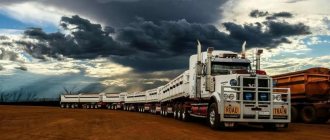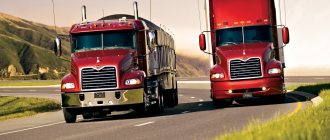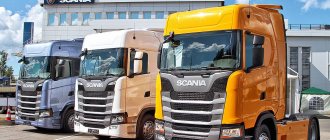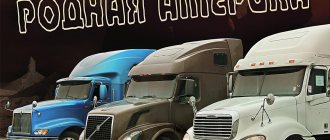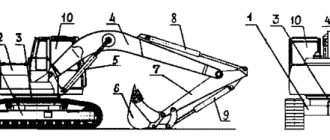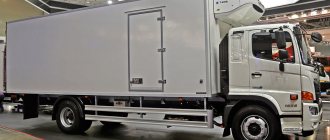General characteristics of American truck tractors
Powerful engines, solid size and recognizable appearance of American truck tractors brought them fame all over the world. The comfortably equipped cabin made them the most favorite vehicles of truck drivers.
The technical characteristics of the cars allow them to drive even on bad roads without serious problems. Tractor units coupled with various semi-trailers and trailers are used in all sectors of cargo transportation.
Manufacturers put a lot of resources into the power units of hooded tractors. Powerful engines can run on fuel that is not of the best quality without breakdowns or defects.
In America there is a whole culture of fans of these trucks. The cars are quite original in appearance - a large hood, chrome elements, vertical exhaust. At the same time, the owners additionally tune them and paint them with airbrushing.
BY THE WAY! Fans of American heavy-duty trucks or “truckers” compile lists of cars, distinguishing between “absolute classics” and similar “classics of the general type.” Trucks are divided by model, year of manufacture and history, taking into account the local traditions of the state.
Purpose and benefits
American hooded truck tractors are designed for transporting goods over long distances on public roads. The areas of application of the mechanisms vary depending on the layout of the semi-trailers: flatbed and body trailers, timber trucks, refrigerators, tanks, etc.
This could be any industry or trade, delivery of large cargo or liquids, and much more.
Detailed information is visible in the video:
Considering the design and main characteristics, American tractors have a number of advantages:
- a carrying capacity of 60 tons is more than sufficient for Russian roads, while our permitted one is 40 tons;
- powerful engines have a very long service life;
- suspension, gearbox and other important parts are distinguished by their reliability in operation;
- trucks have large fuel tanks;
- spare parts for cars are no more expensive than those of their main competitors;
- car repair is not particularly difficult;
- “Americans” have the most comfortable cabins of all tractors existing in the world.
These cars also have some disadvantages for Russian drivers. Firstly, you need to obtain certain permits to bring a car into the territory of the Customs Union, and most importantly, it is expensive.
Secondly, repairing “Americans” requires the use of special inch tools. Thirdly, spare parts for them are not easy to find in Russia. But despite these disadvantages, the number of American tractors on the country's roads is very large, and reviews from owners are mostly positive.
Design Features
Truck tractor from America.
Externally, the “American” design is distinguished primarily by a large cabin and a wide, long hood. From the driver's point of view, this is the main advantage.
The cabin is equipped in such a way that you can live in the car:
- the ceiling height allows you to stand up to your full height;
- there is a full-fledged sleeping place for two people;
- an audio system and TV will not let the driver get bored either on the road or in the parking lot;
- there is a sink, and in some models even a shower;
- the cabin has a “kitchen” with a table, coffee maker and microwave;
- You can store personal items in many drawers and shelves.
The motors are designed in such a way that they operate without overvoltage. The power reserve is large, and this allows trucks to travel a couple of million kilometers without having to undergo major engine repairs.
ON A NOTE! Freightliner Cascadia tractors travel 2.5–3 million km without major repairs. For comparison, the KamAZ mileage declared by the plant without repairs is only 1 million km.
Air suspension makes trucks more passable on dirt roads. The gearbox is without synchronizers in all 16 gears except the first, since synchronizers quickly become unusable. The clutch must be depressed only when engaging first gear, and thereafter it is not used.
The “Americans” have a frame body and are very reliable. Manufacturers in the USA provide a lifetime warranty on the frame. The alloy steel from which it is made does not deform even in severe accidents and departures from the highway. The large hood is excellent protection in case of an accident. Drivers call it “two extra meters of life.”
ON A NOTE! In European cabover tractors, the engine is located under the driver. The “American” is at the forefront of the engine, power body elements, front axle and car lining, which serve as additional protection in case of an accident.
Specifications
Truck tractors from the USA are very durable and reliable.
Characteristics of truck tractors from America.
Their technical characteristics distinguish the “Americans” from other heavy trucks:
- increased load capacity up to 60 tons;
- durable alloy steel frame;
- three-axle base with two driving axles;
- prefabricated cabin structure with elements made of aluminum and plastic;
- diesel engines with a volume of 11–14 liters and a power of 500 horsepower;
- pneumatic balloon suspension;
- non-synchronized gearboxes;
- engine and chassis service life of 2–3 million km;
- power steering;
- satellite navigation and monitoring system;
- climate control;
- audio system
All these options are present in the basic configuration of the car.
AMERICAN TRUCK: LIFE AFTER PURCHASE
American trucks have long ceased to be exotic on our roads. However, their repairs are still not undertaken everywhere. A specific system for ordering spare parts, engines unknown to most servicemen, and an abundance of plastic and aluminum “bodywork” make repairmen wary. There are not many service stations whose workers can actually repair the “American”, and not turn the nuts, guided by the owner’s instructions. One of them is the Bulatnikovo service station, located in Podolsk near Moscow.
We talk with Sergei Vladimirovich Shumov about the peculiarities of operating and repairing American cars in our country.
Sergey Vladimirovich! Why, despite all the variety of cars on the American market, do sellers bring equipment of a certain configuration to us? After all, almost all used “Americans” are three-axle hooded class 8 truck tractors, with a cab and a solid living compartment, six-cylinder in-line engines, two types of 10-speed gearboxes and an adjustable saddle. Is it the peculiarities of the demand of our carriers, the price or the availability of spare parts and repairs? I don't quite agree with the beginning of the question. The first vehicles imported en masse into our country were beige International 9800 cabover tractors. There are still many of them on our roads. Then it was Freightliner's turn. The FLG 120 and Argosy models gave way to the Columbia and Century families in parking lots. Nowadays it is not a problem to purchase a Volvo 770 with its original engine, as well as equipment equipped with Autoshift automatic transmissions. We have already met tractors with Mercedes engines. Kenworth, Peterbilt tractors, and construction equipment use our roads. We are directly involved in this process. Certification tests of the Kenworth T 800 chassis with a concrete mixer, which we imported, are being carried out at the Dmitrovsky test site. So we plan to certify both the chassis and the ability to install special add-ons on it.
As for the design features of the equipment supplied to our country, the configuration of the tractors offered on our market is the required minimum. There are, of course, more expensive and richer cars, but everyone counts the money and doesn’t want to overpay.
T 800: it seems that this is not the first attempt to bring these machines to our country? When I worked at ZIL, there were plans to master the assembly of these machines there. They even created the Novotrak joint venture, but things didn’t go beyond two manufactured cars. At that time, our carriers were not ready to pay a lot of money for unfamiliar equipment of an original design.
Kenworth's second coming should be more successful. After all, there are many tractors of this brand on our roads, and we have accumulated experience in repairing them. Our builders need reliable, durable and inexpensive equipment without any frills. American technology best meets these requirements.
We recently studied the repair of domestic heavy-duty vehicles. It is interesting that not technical, but economic issues have come to the fore: car owners are putting off resolving technical issues in every possible way. Are there any differences among US equipment owners? Likewise, many US truck owners do not monitor the technical condition of their vehicles and prefer to come for service only in the event of a serious breakdown. I believe that not only our poverty is to blame, but also corruption. Despite all the struggles with it, you can still buy a vehicle inspection ticket without even presenting your car. This means you don’t have to monitor the cleanliness of the exhaust, adjusting the headlights, play in the steering, and everything else.
Most repair shops specializing in trucks do not have diagnostic tools. Especially – stands for checking brakes. There are few of them, they are expensive, and most car services are located on rented territory, investments in which are risky. So, the owner of the truck arrives at the instrument control point and does not pass the technical inspection for the difference in braking forces. The drums are sharpened everywhere, the pads are new. There is no skidding when braking to the floor. What should he do? Yes, there is such a problem. But she also has a “workaround” solution. Indeed, the difference in braking forces cannot be determined by eye, and drums are not available everywhere. But you can check the effect of the brakes by negative acceleration when braking. We plan to use special sensors for this that record acceleration and deceleration. If, when braking a vehicle on a special platform, we have a deceleration that meets the Rules, and the sensor does not detect a sideways pull, we can say with confidence that this truck will pass the instrumental control.
And if a slip occurs on a single machine, the faulty brake mechanism is accurately diagnosed. It’s more difficult with a road train; not everything is so simple, but this problem can be solved.
A road train is not only a tractor, but also a semi-trailer. Do you repair the latter? Yes, sure. We have repeatedly seen that the tractor and trailer cannot be considered separately. This is especially true for the operation of an American tractor and a European semi-trailer. And the problem of 12/24 volts and incorrect lighting technology is just the tip of the iceberg. The brakes on semi-trailers are now increasingly electronically controlled disc brakes. If you hook up an American tractor to this, the brakes will work according to the usual two-wire circuit. In dry weather and during service braking in the rain everything is fine. But what will happen if on a wet road the “head”, thanks to the ABS, stands up quickly and without changing the trajectory, and the semi-trailer behaves like on Soviet cars, I think your readers understand. The option “a tractor with ABS and a semi-trailer without it” is much more dangerous on the road than a road train with conventional brake control.
Further, not everyone knows that even with the normal operation of the anti-lock braking systems of an American tractor and a European semi-trailer, proper braking will still not work. European road trains brake in such a way that the brake mechanisms begin to operate in turn, from the rear axle of the semi-trailer to the front axle of the tractor. On the “Americans” the brakes apply all at once. Therefore, it is advisable to adjust the brakes on the entire road train, especially since most owners work with a single semi-trailer.
When it comes to spare parts supply, US-made semi-trailers are becoming more and more like tractors. If earlier my mechanic, having read the nameplate, already knew what spare parts for the axles and brake system would be needed, now everything is more complicated. Like trucks, a VIN is required. So it’s better for equipment owners to bring a hitch for repairs.
Is it possible to identify the main reasons for unscheduled repairs of American rolling stock? Apart from cases of recovery from accidents, the most common malfunction is called “the car does not move.” Most often this is due to an engine malfunction, but there are also more interesting cases.
Most drivers, knowing the reliability of American technology, do not bother to carefully study its design, especially since there are no special conditions for this. The available literature has a clearly “consumer” bias. Electrical circuits are either missing or provided in pieces. The designations on them are incomprehensible to most electricians working with Soviet-Russian electrical equipment. Often the driver does not even know where the fuses are on the car.
Not long ago, the owner from Tula called us and asked us to leave because the car would not start. Since the work for our traveling crew at that moment was scheduled long in advance, the owner of this tractor paid 20 thousand rubles. brought him to us. It turned out that in order to dig out three fuses from the pile of dirt that had accumulated around the battery compartment and change one of them.
Gentlemen, owners, there is no benefit for us for 300 rubles. change your fuses! Study the structure of your machines at least a little!
You can also recall an interesting repair of a Peterbilt tractor. A car driving along the highway was struck by lightning. The driver lost consciousness and the road train ended up in a ditch. Of the electrical equipment, only the instrument panel control unit was damaged. So much for unreliable electronics!
Valery Raevsky agreed to answer questions regarding the engine.
Red, yellow, green. These are not the names of traffic light colors, but the colors that American engines are traditionally painted in - Cummins, Caterpillar and Detroit. Jokingly, Valery says that they used to differ mainly on this basis. No, of course, there are differences between native American engines in the location of units, adjustment parameters, and assembly and disassembly features. But in general, we can say that all the engines of the “Big Three” are ideologically the same. These are in-line six-cylinder engines, somewhat less boosted than the “European” ones, and with more torque. But this is true for engines manufactured before 2002.
You talked about the similarity of the engines, both structurally and in character. But it seemed to me that DDs, for example, are not very resourceful, but they “pull” better at the bottom. This is a matter of the operation of the program embedded in their “brains”. Manufacturers can program the peak engine torque at both low and medium speeds for different operating conditions.
Sorry. Let's go back to engines manufactured after 2002? The main thing is that the design ideology has changed. If previously reliability and fuel consumption were put at the forefront of design and modernization, then after the introduction of standards approximately close to Euro-4 in the United States, the main thing became to meet them. As a result, all American engines produced after 2002 acquired an exhaust gas recirculation (EGR) system and require more attention both in terms of maintenance timing and the quality of consumables. EGR malfunctions are also not uncommon. The largest number of requests are for DD motors. This is facilitated by their greater distribution, especially the 60 series.
Which engine, in your opinion, is the most reliable? As a repairman, I prefer Caterpillar. A very good Cummins 14 engine. In all my practice, I remember only one request for a major overhaul of such an engine. But it was a “two-million-dollar” building undergoing scheduled repairs. It still worked, but with high flow and low oil pressure. This engine is also supported by the fact that in the post-perestroika period ZIL equipped its cars with an engine of this brand. ZIL-4331 with a Caterpillar engine is still working at our service station.
City and suburban buses "Liaz" are also equipped with Caterpillar. But not everything is clear there. Diesel loves to work under load. And on a city bus it works almost idling 95% of the time. The bus stands either at a stop, at an intersection, in a traffic jam, or rolls with the gas pedal released. Engine maintenance is carried out simultaneously with bus maintenance, every 10 thousand km, but this is not frequent enough. When repairing city car engines, we constantly find deposits indicating oil recycling. The same cars operating on suburban routes do not have such problems.
But when choosing a car, the main thing is not the brand of the engine, but the correct selection of the engine and transmission gear ratios for the job being performed. There are no bad or good engines.
About unscheduled repairs. It’s probably more convenient for you to work if at least something is known, at least approximately, about the cause of the truck breakdown. What preliminary diagnostic measures can you recommend to a driver if his car suddenly stalls or stops starting? You're right, it's very difficult to work on call. Especially if the driver has no idea about the structure of the equipment he is working on. “The car is not . You drive and wonder why. Meanwhile, drivers can significantly reduce repair time, and in some cases even do without visiting a service center, if they perform a number of simple checks.
1. After turning on the ignition, pay attention to whether the instruments are being checked, fuel is being pumped (on cars with an electric fuel pump) and what signals light up on the control panel. Perhaps there is no malfunction, but the diesel engine was turned off by the automation. Of course, if nothing happens at all, you need to look for an oxidized contact or a blown fuse.
2. Check the fuel pressure after the booster pump. On cars with electric pumping, you can simply do this yourself by turning on the ignition, and if there is no such option, ask a friend to turn on the starter. It is not necessary to unscrew the fuel pipe for this; most fuel priming pumps have a plug, by unscrewing which you can screw in a pressure gauge.
3. Pay attention to the warning lights.
Why do engines in the USA start in winter using ether? At what temperature is it preferable to start using it, and how can this be done safely? The opinion that it is impossible to start a cold American engine without ether is deeply erroneous. If you have fuel appropriate for the season, starting a working engine is not a problem. Another thing is that cars intended for use in Canada were initially equipped with ether injection systems. Our drivers are accustomed to using ether in case of any difficulty caused by either a really low temperature or a malfunction of equipment, or the use of fuels and lubricants that do not meet operating conditions. Very quickly, “best practices” spread to all American trucks. As a rule, difficult starting is a symptom of the presence of several malfunctions at once, and it is necessary to identify and eliminate them. A working engine does not need ether.
Finally, they showed me a Kenworth 660 truck tractor, designed specifically for Russia. When you read these lines, the car will go for certification tests, but for now - a brief introduction.
At first glance, this is a “hood” with a 6x4 wheel arrangement, not much different from the new and used American cars we already have, but this is not entirely true. The first pleasant surprise awaits under the hood. There is no recirculation system, so disliked by repairmen. The tractor is prepared to meet Euro-3 requirements. The fuel system has also become a little simpler. Now diesel fuel does not cool the control unit. And the turbine is simple - without adjusting the boost pressure.
The gearbox remains purely American - a five-speed, dual-range unsynchronized Eaton (five gears “down” and five “up”), but all the differentials on the car are locked - both inter-wheel and inter-axle. Interestingly, there is a separate key for each lock. New items await us in the suspension. Although it is still combined, a rigid beam has taken the place of the half spring. On the other hand, as before, there are air cylinders. The electrical equipment is designed to work with a 24-volt semi-trailer.
The biggest blow for fans of the purity of the American style awaits in the cockpit.
Not only is the instrument panel now very similar to the European one, but the integral attributes of all American trucks have disappeared - push-button switches for the parking brake and air supply to the semi-trailer. Instead, there is a completely “European” lever. Time will tell whether such cars will find their buyers, but the preliminary forecast is favorable. The crisis does not last forever, but in terms of price-quality ratio, equipment from the USA looks good. Share
Leading manufacturers
There are not many manufacturers of real American heavy trucks. The top ten includes such brands as Kenworth, Freightliner, International, Caterpillar, Autocar, Mack, Sterling, Peterbilt, Marmon-Herrington, Western Star. A large number of companies founded in the first half of the twentieth century are industrial giants.
Peterbilt
Peterbilt was founded in 1939. The main factories are located in Texas. The cars produced have a classic look with a large hood, but there are also cabover models, for example, the Peterbilt 362.
In 2008, Peterbilt trucks were first equipped with a hybrid engine, which is still used on other models.
BY THE WAY! The heavy-duty truck, in the cabin of which the character of the cult film “Brother 2” Danila Bagrov rode, is a Peterbilt 379. And the Peterbilt 389 is nothing more than “Optimus-Prime” from the blockbuster “Transformers”.
Volvo
Since 1981, the European one has settled in the American market. Having purchased controlling stakes in White and Autocar, Volvo began working with General Motors and producing White GMC cars. Volvos have retained the appearance of classic American tractors, but their cabs have become more streamlined.
Detailed information is visible in the video:
Freightliner
Production of Freightliner trucks began in 1929. The company produced cabover and hooded tractors equipped with the most modern technical solutions.
The Freightliner FLD 120 truck has received full recognition among heavy-duty truck drivers for its excellent aerodynamics and driving performance. Because of the interior design of the cabin, it is called the “American dream on wheels,” and our truck drivers give cars of this brand funny nicknames “Fred” or “Freddy.”
Kenworth
Industrial production of Kenworth trucks began in 1923. Until 1957, the company also produced buses. But the main focus has always been truck tractors and dump trucks.
Currently, Kenworth is part of Paccar, the world's third-largest truck manufacturer. Car production plants are located in the USA, Canada, Mexico and Australia.
BY THE WAY! Kenworth and Peterbilt are owned by the same Paccar corporation. But the owners of these heavy trucks compete with each other over whose vehicle is better, even though the trucks are equipped with the same parts.
Other manufacturers
International has been producing trucks from 1902 to the present. There was a period when passenger cars were also produced.
Caterpillar produces mining and construction equipment, and supplies truck tractors only to the Australian market.
The Mack company began operating in 1900 and produced buses and then heavy trucks. Mack has been owned by Volvo since 2001.
One of the oldest American companies, Autocar, was also purchased by Volvo in the 80s. But in the 2000s, it was returned to independent status at the request of the US Antitrust Service.
Marmon cars, produced from 1963 to 1997, were called “Rolls-Royce trucks.” They were collected by hand, only by prepayment and pre-order.
The Sterling company, which produced trucks, special equipment and pickups over the years, was liquidated for economic reasons.
Western Star is a division of White Motor that was resold several times, but regardless of this, the company produced classic-looking heavy-duty trucks.
Detailed information is visible in the video:
American or European? — choose a truck tractor... the choice is yours...
We owned and operated two types of truck tractors: American Freightliner FLC 120, with a Detroit Diesel DD 60 engine, Rockwell axles and a 10-speed manual transmission Eaton Fuller, and European MAN ) 19.414 commander with 8-speed manual transmission and divider. General impression. Of course, the American wins in appearance: massive thoroughbred appearance, superior engine power, pre-heater, huge cabin - actually a house on wheels: microwave, tables, TV, two huge sleeping bags. Power windows, stereo system, air conditioning, two stoves - everything for convenience! The advantages of the American, of course, include the availability of spare parts, their low cost and almost constant availability in stores. The computer, or more precisely, its capabilities, is also impressive: at the slightest discrepancy between the engine temperature, oil pressure, and oil temperature, it turns off the engine, eliminating the possibility of overheating. Gearbox - without synchronizers, hit 1200-1400 rpm on the tachometer, engage a higher gear, drop the rpm to 800 - engage a lower gear - it's simple! The clutch is ceramic; it moves once, the pedal is tight, you don’t want to press it again. The European is compact, designed in a minimalist style, and German punctuality is felt everywhere. There are two sleeping bags, one window lift, for the passenger - so that the driver doesn’t even think about reaching out to tighten it. There is also a radio tape recorder. The cabin volume is three times less than in its American counterpart. The gearbox and clutch are ordinary; drivers who had previously only driven our tractors sat behind the wheel and after the first trip they understood how everything should actually work in their cars. Performance. Americans: all the seals on the bridges started leaking at once. Moreover, if on the first tractor on which this happened they changed the oil seals one by one, on the next ones they simply changed everything without looking. Then it was time for crosses. They changed all the tractors in turn, and “just in case” they bought the drivers one “big” and one “small”. To be fair, it should be noted that the tractors came back from a trip, the driver complained about a “slight vibration” that appeared 1000 km before unloading places. We drove the tractor into the pit and observed the picture: there was simply no crosspiece on the rear drive axle - the needle bearing on two of the four joints of the crosspiece was completely missing! The backlash exceeded all possible limits! At the same time, the tractor reached the garage. , quite serious breakdowns still occurred . It is well known that the piston in American engines consists of two parts: the upper one is aluminum and the lower one is steel. It was this top part that kept breaking off. Well, if the upper part remained at TDC, then the engine began to bleed, bleed and stall. If the upper part of the piston ended up in the middle of the piston stroke, everything went according to a sad scenario: a piston stub upwards, an impact, a bent connecting rod and a disaster... By the way, the saddest end of the engine was one of ten: a bent connecting rod, deformation of the crankshaft, a broken block. Fortunately, there was only one. The mechanic at our production turned out to be a smart guy and upon receiving a freshly driven car, he disassembled the engine and tightened the bolts inside the piston. The rest was minor: there were problems with the wiring on cabover tractors, a problem with American-sized tires, and very decent wear on the saddle. It became clear after several tractors: you can’t take tractors from under - the poorest in terms of equipment and the most “gone.” Europeans were surprised by their resistance to frost and the presence of gasoline in diesel fuel. And peace of mind for the “on-air” launch. At the same time, they made such sounds when starting up that it seemed like the engine was already knocking. I was very upset by the rate of wear of the brake pads; perhaps the supplier brought low-quality ones. Fuel consumption is still lower with the same power as on the American car. There were problems with spare parts - they ordered according to the VIN code, but they delivered the wrong thing. Again, we blame everything on the stupidity of the supplier. With all this, the Europeans as a whole let us down much less often. For more than a year of operation, European tractors have never required a “call for technical assistance,” while the Americans have required it 3 times. The total costs for maintenance and spare parts when operating American and European tractors are comparable. Europeans break down less often, but spare parts are more varied and specific and, as a rule, more expensive. Americans are more predictable: if one thing breaks, prepare spare parts for everyone. Our opinion : if you are purchasing a truck tractor and are going to operate it personally, take a European one : it is more maneuverable, breaks down less often, and, as a rule, has 2 axles. One drive axle has its advantages: there is no complex center differential, and it has 4 wheels instead of 8, which significantly saves money when changing tires. Moreover, semi-trailers most often use European, 3-axle ones. Americans will be good at large garages, where they can keep a relatively small number of spare parts and at the same time keep almost all existing equipment running. In addition, the Americans are designed for a long shoulder - it is very inconvenient to enter and exit our Soviet bases, designed for horse-drawn carts. Equipment maintenance service is completely absent today. For both Europeans and Americans. The branded stations that exist today are a useless waste of money. One case is memorable: it was necessary to replace an outboard bearing on a European tractor; a puller was required. We called the station, made an agreement, and sent a driver. The cost of the bearing turned out to be three times higher than what we could have bought (the original one), but when they wanted to start changing it using a sledgehammer and pry bars, we were shocked - they didn’t have a puller! Therefore, for relatively large garages it is better to keep a couple of smart ones on staff mechanics and a craftsman who understands the range of spare parts. For Americans, be sure to find a competent electrician, since 85% of the errors that the computers of these tractors produce have nothing to do with reality and are most often associated with oxidation of contacts and broken or shorted wiring.
Difference from European
Truck tractors from Europe and America differ greatly from each other in many respects:
- the large hood of the “American” and the flat vertical front of the “European”;
- drum brakes on American models and mostly disc brakes on European ones;
- the number of bridges for “Americans” and “Europeans” is 2 and 3, respectively;
- American models do not have underrun devices on trailers, which European and Russian heavy trucks are always equipped with;
- American trucks have a voltage of 12 V, while European trucks have 24 V.
Another characteristic feature of the “Americans” is that these tractors are medium and heavy at the same time. And the classification depends only on the engine power and the type of gearbox.
BY THE WAY! On the Internet you can find many comparisons of European and American type trucks, equipped with photos, as well as different ones on them.
Where can I buy
If you consider purchasing these used vehicles, it is extremely difficult to assess the condition of the truck based on pictures from advertisements. There is a risk of buying a car with serious defects. The cost of an American tractor in operation starts from 1–1.5 million rubles and increases depending on the year of manufacture, configuration and technical condition.
It is impossible to buy a new American tractor in Russia. There are cars without mileage in the Russian Federation that are sold by organizations involved in the supply of trucks from the USA. The price of such a car is higher, around 2–4 million rubles.
An American truck, or in other words, a used American truck tractor costs much higher than a European and domestic truck. During operation, difficulties may arise with the car, given that it was not created for our country. At the same time, the indisputable fact is that American heavy trucks have long taken leading positions in the field of cargo transportation.
Detailed information is visible in the video:


